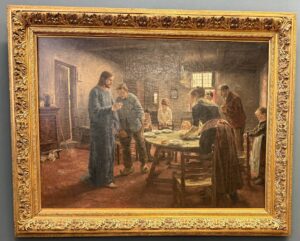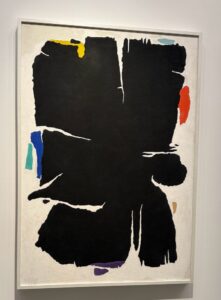The Art of Germany
Berlin is a city well known for being massively progressive, famous for its culture shocks almost as much as it is for its history. Everything from the Ampelmann to the people around you makes the Berlin experience so interestingly different from any other city that it’s impossible to forget where you are. Knowing this going in and having a list of important/interesting things that I wanted to see during my time there, I think that the experience I found the coolest was my visit to the New National Gallery, Germany’s continuation of their old National Gallery which brings an interesting shift in style with its continuation of the old gallery’s collection.
Having been tasked with finding and experiencing a museum as one of the final parts of our Berlin study trip, I decided to make my way to ‘Museum Row’ – a massive strip with a plethora of incredibly interesting museums – where I found Germany’s Old National Gallery, my first stop. By enlarge, I found this museum to be interesting but extremely predictable – impressive, old works by impressive old artists, just like you would find in almost any national gallery. It is made abundantly clear from the museum’s first exhibit that while the history of almost every piece there tells an incredible story, the museum itself doesn’t really intend to bring them together in any meaningful way. None of the pieces labeled with anything beyond a title card, it was obvious that while there was much to see, there wasn’t much

to learn at the old gallery. On my way out, realizing that I still had time to explore before I needed to be anywhere, I followed my curiosity to the New National Gallery, where I expected to find another similar, standard museum experience.
Walking into the new gallery, it became abundantly clear from the beginning that this prediction was completely wrong. Everything from the first sight of the entry-floor exhibition to the staff at the entrance immediately told me that this experience was designed to be completely different than the old gallery – the old gallery expressed Germany, this was designed for Berlin. The ground floor was home to a temporary exhibition by American photographer Nan Goldin1, who used music-backed slideshows in dark rooms to tell stories and develop messaging surrounding her personal life experience with topics like the innocence of childhood, the LGBQT communities with which she often found herself involved, and an attempt to perceive life from the perspective of an addict. These 20–40-minute shows constantly grabbed my attention, telling Goldin’s story and expressing her message using usually only a collection of photos and well-chosen soundtracks. As this was my first stop in the museum after seeing the old gallery, this kind of unique, expressive interpretation of art massively juxtaposed the plethora of classic paintings and sculptures that I had just finished seeing at the old gallery and quickly shifted my mindset to accommodate what was to come as I walked downstairs to see the rest of the museum.
The new Gallery’s main collection was incredibly interesting, including pretty exclusively what most would consider ‘modern art’ which challenges what many would consider to be art at all. I find art like this to be interesting because while you are meant to look at the piece itself, most people (often including myself) find it extremely hard to pull meaning from pieces with as much abstraction as was often exhibited at the new gallery. Because of this, only about 2/3 of the wall space used was actually taken by the art itself – the rest

was devoted to explaining to the viewer what exactly they were looking at. This, in my opinion, added so much more substance to the museum than could possibly be added by replacing it with more art. Small text boxes explained historical significance behind why a style was created and what it is meant to mean, leading the viewer not to a conclusion, but to a point where they were able to feel comfortable finding a conclusion on their own. While I have seen text like this in other museums – explaining the meaning behind both the styles and the pieces themselves – I would consider this to be one of the best uses of supplementary uses of text that I have seen in an art museum, and maybe the first time that I’ve seen almost everyone there actually reading it.
Although the old gallery’s presentation was substantially larger and grander than that of the new gallery, I appreciated the new gallery’s ability to bring pieces with similar messaging together as a way to reinforce the meaning behind the works. The new galley focuses on art as a method of political and social messaging, heavily emphasizing the use of abstraction and performative works to deliver a more personalized message to the viewer.
As I passed the ticketing counter on my way out of the new gallery, I saw that the museum hosts a weekly, Volkswagen-sponsored free admission period, where everyone is invited to come see and experience the museum free of charge as a part of what seems to be an attempt to bring the public closer to the arts and develop mass literacy for interpreting this kind of abstract political messaging. While this meant that the museum was packed near the end of my visit, I think that this means that the museum’s (and seemingly Volkswagen’s) efforts to educate the masses on less traditional forms of messaging are being well received, which I consider to be a good thing.
All in all, while they seem impossible to compare given their completely different styles and goals, I found myself enjoying the New National Gallery more than I did the old because of its more aggressive efforts to inform rather than just to display its works, although both museums excel at their respective goals.
Sean M
